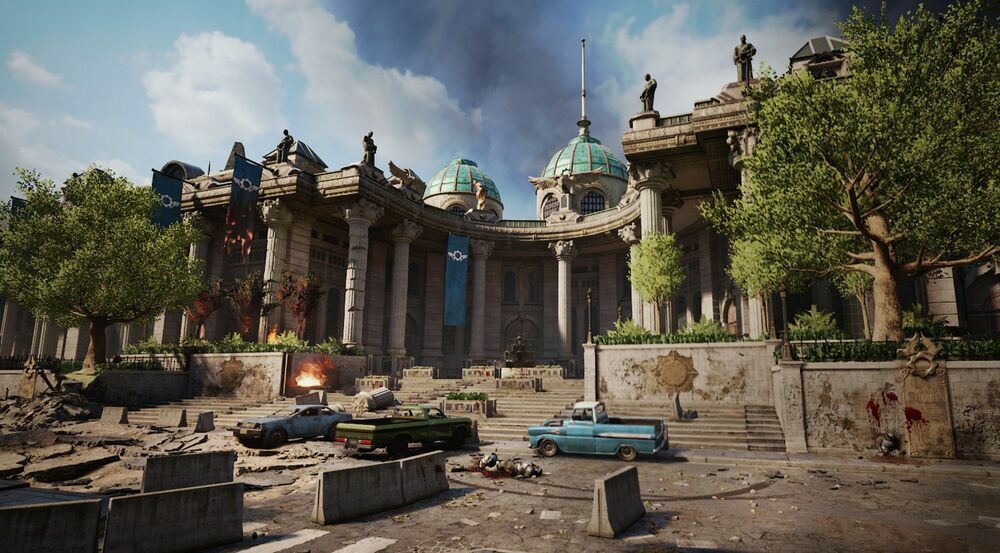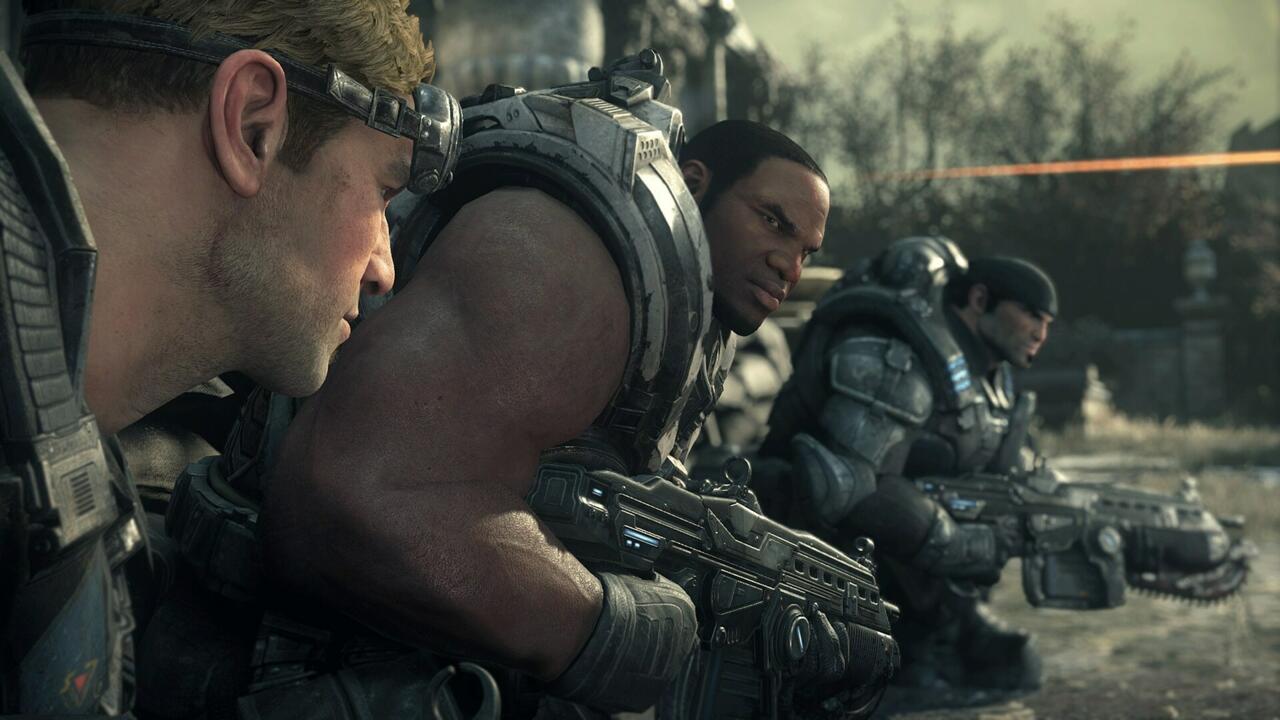Outside, shrapnel slams into stone walls and bodies crunch into the cold comfort of cover as tracer fire explodes over the heads of soldiers. Inside, there is relative peace. Statues of old heroes stand, worn and decayed, but still erect. Stained glass windows are shattered, scattering diffused light across the domed structure. At once, the sounds of battle end. Footsteps crunch closer to this forgotten building. In the center of these ruins is a table, dented with shrapnel, overgrown with vines. Beaten into its surface are the words:
Order. Diligence. Purity. Labor.
Gears of War is the story of fascist empire in decay. While the game’s opening cutscene gestures at a time of peace, it must have been a brief one. A scant few years after destructive resource wars ravaged the planet Sera, the Locust–think orcs with guns–arose from the earth. Somehow undetected, the Locust brought the human Coalition of Ordered Governments (COG) to the brink of extinction. Gears of War starts around 13 years after this conflict began. Freed from prison, former sergeant Marcus Fenix and his old friend Dom Santiago attempt to find the superweapon that might end the war. To do this, they drag themselves through ever deeper layers of hell until they succeed, but only briefly. The war they sought to end will continue. Gears of War is thus lean and oppressive. Exposition is stripped to the bone, as Marcus and crew fall into set-piece after set-piece, always surviving by the skin of their teeth.

Despite being part of a massive military organization, Marcus receives almost no help, outside of intel and the occasional flipped switch. The game opens with Marcus jailed for unknown crimes, but Dom makes it clear that he was unjustly imprisoned by the COG. In short, though the soldiers represent their government’s right arm, they are just as often abandoned by it.
The oppression of the COG feeds into Red Scare rhetoric. The aforementioned inscription of labor is an empty gesture to the Soviet bloc. However, whatever intended critique of socialist or communist nations is soundly overwhelmed by fascist signifiers. The COG are a viciously hierarchical military society that use an ethnic scapegoat as an excuse to dominate and control the population. The Locust are literally a degenerate other that must be completely destroyed. Furthermore, the COG’s aesthetics easily echo the classical influences of the Nazi party, albeit churned through the exaggeration of pop artists like Rob Liefeld. The COG are fascists. There is practically no other way to read them.
In part, Gears of War presents the COG as a grim necessity to an existential threat. The Locust want to kill absolutely every human being, whether they are fascists or not. In this first game, the Locust have no redeeming qualities. They are intelligent but brutish, an amalgamation of evil traits that our human heroes will turn into blood and guts. Later entries will complicate their unambiguous evil, tying their rise to the COG’s hidden crimes and their relentless mining of Imulsion, a kind of mega oil that caused the 79 years of resource wars. Later games make it more explicit that the Locust’s war against humanity is also one of survival. To be fair, there are gestures at those reveals here. Some Locust glow, infected with the taint of Imulsion. In one level, Marcus and his gears go deep under the earth in an Imulsion mine. The cavern is barren and open, flowing with the dangerous liquid. The implication is that the mining drove the Locust out of their home. Nevertheless, in 2006’s Gears of War, they are primarily monsters.

However, Marcus and his fellow COG soldiers (referred to as Gears, get it) are monsters, too. They have the same gait, wear similar armor, and bear the same grim determination. Gears of War is a horror game, and part of that horror is the relentless destruction the Gears, and by extension the COG, have wrought and continue to wreak. The COG once built a great deal of infrastructure, of monuments to its own glory. All these places are now decayed and dead, unpopulated, except by scavengers abandoned by the COG. Even Gears of War’s oft-maligned color scheme has its role to play. The game’s settings only really have two colors: decayed gray and blood red. Even if the game presents the COG’s fascism as necessary, it also shows that they do little to protect the vulnerable and only a little more to protect their own. Their once-grand cities are dead, and maybe nothing will ever bring them back to life. Even Marcus says their monuments are built on lies.
That resourcefulness is not free from the COG’s cruelty. The Gears are callous whenever they interact with ordinary people. In the first Gears of War, you encounter no citizens of the Coalition. Rather, you find a few Stranded, those who attempt to survive outside of the COG’s influence. The COG is bad, sure, but those who live outside are simple jokes, petty criminals, or curmudgeonly shop owners. A specific Stranded, the lone character who calls the Gears fascist, is devoured by Locust instantly afterward. It is a comic moment, not a tragic one. While the Gears are granted a simple nobility by fighting in a system that exploits them, those who want no part of that system are merely mocked. In the context of the whole series, though, it reinforces the franchise’s grand tragedy. There is no outside of the COG. That possibility died when the Locust emerged from the dead earth. Even the humanized stranded of later games, to whom Marcus reacts with more than just distant annoyance, are either assimilated into the COG or die. Humanity’s options are either oppression or death.
It must also be said: Gears of War has horrific representational politics. The game’s primary Black character, Cole, is a caricature of stereotypically African-American affect. Cole is an understandable and unthreatening portrait of Black masculinity rendered for a presumably white audience. In addition, women appear on-screen about two times in total. Representative perhaps of the horrific way they are treated off-screen, forced into institutionalized sexual assault to repopulate the human race. Any intended criticism of the COG is rendered inert by the game’s own cruelty toward the marginalized.


The sins of the COG only truly settle in Gears 4 and 5, which do their best to show the COG’s fascism as explicit and horrific. In those games, the COG’s superweapons are portrayed with the terror of WMDs, the Locust rise out of mass graves, and the force of their threat renders all resistance to the COG helpless. Marcus Fenix’s namesake is revealed not to be a hopeful symbol, but a grim portent. From ashes, fire, over and over again.
However, any attempt to take Gears of War seriously must acknowledge its catastrophic ludicrousness. There are flying enemies called Nemicyst, which explode into green goop when killed. At one point, Marcus fights his way through the “Contemporary Combat Center” at an abandoned university. The soundtrack, with its high school band-like horns and sharp strings, makes it sound like the Locust are forgotten denizens of Halloween Town. Any and all world-building is peripheral to an escalating set of horror-action set pieces. However, that ridiculous bluntness is what lends the franchise its strange power.
At the end of Gears of War, there is a brief moment of victory. Then, the camera cuts away to the Locust, promising that they will continue to fight. The war will simply continue, until everything is dead. Early in the game, Marcus jokes about Dom owing him 20 dollars. Dom retorts, “See me after the war.” The implication is that the war will never end or that neither of them will live to see it end. Even as the game adopts the rhetoric and aesthetic of fascism, it also knows where all this heartless violence will lead.
Gears of War remains compelling, because of its ugliness, because it leans into its viciousness rather than cloaking it in shame. Its destructive portrait of a world in a hideous double bind is stark and melancholy. In an age when obviously regressive franchises like Call of Duty or Far Cry attempt to cower under superficial representation and progressive signals, Gears of War’s blunt horror is almost refreshing.
Almost.



